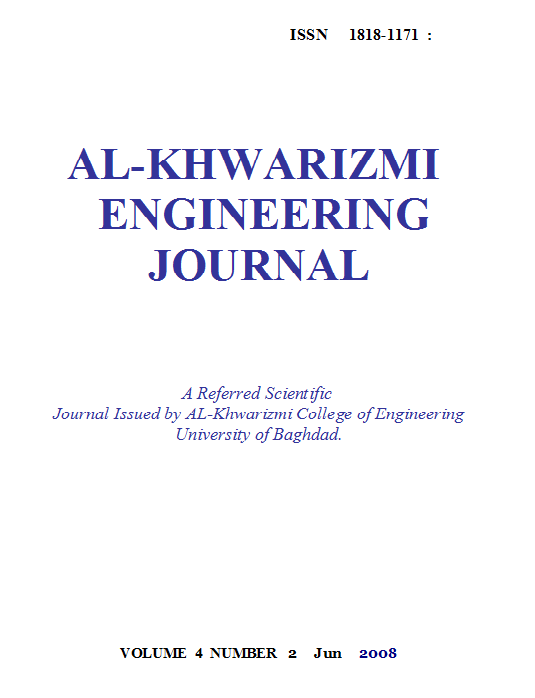Hydrodynamics, Mass and Heat Transfer in Reactive Distillation
Abstract
The ethyl acetate synthesis via heterogeneous reactive distillation is studied experimentally using ethanol and acetic acid. Three types of cation exchanging resins were used as catalysts: Zerolit 225, Zerolit 226 and Ambylite 400. Experiments were carried out in two units of the same dimensions. Each unit consisted of three sections: rectifying, reactive and stripping sections of heights (60+25+20) cm respectively and 2.5cm column diameter. The first unit (column-A-) was a fractionation type and the second unit (column-B-) was packed column. The packing type was hollow glass cylinders with 10 mm height, and 4, 5 mm inner and outer diameter respectively.
The experiments were carried out by using two operation modes. The semi-batch and continuous operation mode. In the first part of present investigation, the semi-batch mode was used to evaluate the catalyst type and to evaluate the performance of reactive distillation unit configuration (Fractionation and packed column). Results show that, the column-B- gave higher conversion rates than column-A-. This is attributed to the high surface area available for liquid vapour contact in packed type column, which leads to increasing mass transfer rates. On the other hand, Ambylite 400 catalyst showed higher activity for esterification reaction than other two types of catalysts.
The second part of work continued with column -B- only. It is well known that, the esterification process is regarded one of exothermic reactions. Therefore, the monitoring of the temperature distribution along column axial for all three types of catalysts showed that the temperature distribution was essentially the same due to steady state operation in continuous operation mode. On the other hand, the effect of reflux ratio on temperature distribution was clearly noted, that is as the reflux ratio increased the temperature distribution along the column was reduced for each type of catalysts.
On the other hand, the experimental results point that, as a reflux ratio increases the conversion rates of acetic acid is increased too because such increasing is related to high mass transfer rates between vapour and liquid along reactive distillation column.
Downloads
References
[2] Saha, B., Chopade, S. P. and Mahajani, S. M., “Recovery of dilute acetic acid through esterification in a reactive distillation column”, Catalysis Today, 60, 147-157 (2000).
[3] Xu, Z. P. and Chuang, K. T., “Kinetics of acetic acid esterification over ion exchange catalysts”, The Canadian Journal of Chemical Engineering, 74, 493-500 (1996).
[4] Aiouache, F. and Goto, S., “Reactive distillation-pervaporation hybrid column for tert-amyl alcohol etherification with ethanol”, Chemical Engineering Science, 58, 2465- 2477 (2003).
[5] Bianchi, C. L., Ragaini, V., Pirola, C. and Carvoli, G., “A new method to clean industrial water from acetic acid via esterification”, Applied Catalysis B: Environmental, 40, 93-99 (2003).
[6] Tang, Y. T., Huang, H.P., and Chien, I. L., "Design of a Complete Ethyl Acetate Reactive Distillation System", J. Chem. Eng. Japan, 36, 1352-1363 (2003).
[7] Tang, Y. T., Huang, H.P., and Chien, I. L., "Plant-Wide Control of a Complete Ethyl Acetate Reactive Distillation Process", J. Chem. Eng. Japan, 38, No.2, 130-146 (2005).
[8] Chang, Y. A., and Seider, J. D., “Simulation of continuous reactive distillation by a homotopy-continuation method,” Chem. Eng. Sci., 12, 1243-1255, (1988).
[9] Bock, H., Jimoh, M. and Wozny, G., “Analysis of reactive distillation using the esterification of acetic acid as an example,” Chem. Eng. Technol., 20, 182-191, (1997).
[10] Gangadwala J., Mankar, S., Mahajani, S., Kienle, A. and Stein, E., “Esterification of acetic acid with butanol in the presence of ion-exchange resins as catalysts”, Ind. Eng. Chem. Res., 42, 2146-2155 (2003).
[11] Gangadwala, J., Kienle, A., Stein, E. and Mahajani, S., “Production of butyl acetate by catalytic distillation: process design studies”, Industrial and Engineering Chemistry Research, 43, 136-143 (2004).
[12] Teo, H. T. R. and Saha, B., “Heterogeneously catalysed esterification of acetic acid with iso-amyl alcohol: kinetic studies”, Journal of Catalysis, 228, 174-182 (2004).
Downloads
Published
Issue
Section
License
Copyright: Open Access authors retain the copyrights of their papers, and all open access articles are distributed under the terms of the Creative Commons Attribution License, which permits unrestricted use, distribution, and reproduction in any medium, provided that the original work is properly cited. The use of general descriptive names, trade names, trademarks, and so forth in this publication, even if not specifically identified, does not imply that these names are not protected by the relevant laws and regulations. While the advice and information in this journal are believed to be true and accurate on the date of its going to press, neither the authors, the editors, nor the publisher can accept any legal responsibility for any errors or omissions that may be made. The publisher makes no warranty, express or implied, with respect to the material contained herein.












